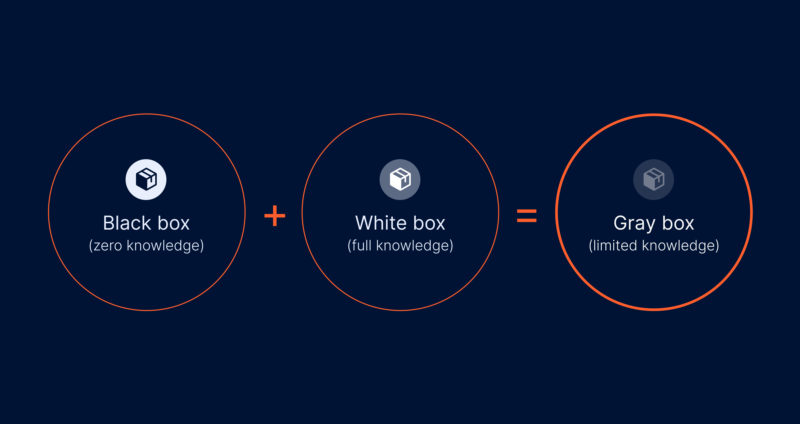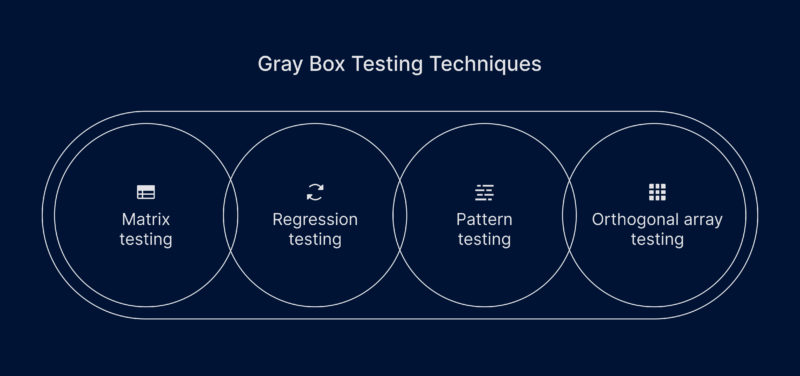
Contact us
Our team would love to hear from you.

The importance of software quality has grown significantly in recent years due to the increasing dependence on technology in all aspects of business. Ensuring that software products are reliable and operate well is essential to avoid costly errors, mitigate risk, and maintain the trust of users and stakeholders. It is also important to timely identify and address potential issues before they become significant problems. Applying the gray box testing (or grey box testing) approach can enable companies to achieve these objectives.
This article provides an in-depth look at gray box testing, including an outline of the process and techniques involved as well as the advantages and drawbacks of this approach compared to alternative methods, to help companies understand how gray box testing can be utilized to improve software quality.
Gray box is a software testing approach in which a QA specialist with only partial knowledge of an application’s internal structure analyzes both the code operation and the way the application is used. It combines elements of black box and white box testing, offering a balanced approach that allows testers to leverage the strengths and minimize the weaknesses of these alternative assessment methods.

The key features of gray box testing are as follows:
Gray box can be applied to different types of testing, including gray box penetration testing, which provides a security assessment of a particular system component. For example, gray box testing is also used for integration testing, where individual system components are combined and checked in a group, and domain testing, which examines whether each module in a software system accepts inputs within the accepted domain and delivers the required outputs.
Gray box testing may be used to assess a web application that contains links to different posts. In this case, the tester checks the following aspects:
Using a white box approach, a QA specialist only tests the URL parameters and if the HTML points to the proper URL. With black box testing, the QA specialist only checks link clickability.

There are three approaches to software testing: black box, white box, and gray box. The main difference between these approaches is the amount of access the tester has to the internal information and source code.

Compared to black box testing, the gray box approach, as well as the white box, provides a deeper understanding of an application’s underlying technology and architecture, making it easier to identify technical issues. At the same time, compared to white box testing, the gray box approach gives a more realistic view of software quality by incorporating user context into the testing process.
Knowing the advantages and limitations of each approach helps organizations determine the most appropriate testing method for their specific needs.
Several techniques may be employed in gray box testing, depending on an organization’s objectives and the issues that the assessment is intended to address.

This technique is applied to define the variables of a program and assess the risks they pose. Variables are used to store and label data to be referenced and manipulated within a program. Matrix testing analyzes the performance of variables and identifies the unused or inefficient ones.
Every change made to an application has the potential to lead to errors. Regression testing is used to ensure that modifying a program does not cause new bugs and does not impact the functionality of the program.
This testing technique analyzes past errors to establish the patterns that led to their occurrence. It is used to keep a record of all such issues and their causes and to create test cases to prevent similar errors from arising in the future.
Orthogonal array testing is a statistical approach that is used when the tested software has large data inputs. It maximizes test coverage by combining inputs and testing the system with a small number of test cases. This reduces time consumption and costs associated with software testing.
Automating the testing process and optimizing the necessary tools simplify the gray box testing procedure. The main steps involved in gray box testing are as follows:
Various tools may be used in gray box testing. Among the most popular are Selenium, Appium, Postman, JUnit, NUnit, DBUnit, Cucumber, Burp Suite, RestAssured, Chrome Dev Tools.

In software engineering, gray box testing offers a range of benefits.
The gray box approach involves the application of clear testing goals to check a specific software component. It also considers both user and developer perspectives, improving the quality and efficiency of the testing process.
Gray box testing provides better test coverage than black or white box testing alone. It incorporates internal and external testing elements into the testing process and examines both the architecture of the application component and the application’s functionality from the end-user’s perspective.
Gray box testing identifies and mitigates potential issues before they become significant problems, helping organizations enhance risk management. With access to particular system components, testers can ensure that bugs are fixed immediately after detection and subsequently check how the changes improve software performance.
However, certain aspects of the gray box approach may have an adverse effect on the testing process:
Although gray box testing provides a more comprehensive view of software quality than black box testing, it may not offer the depth of white box testing, as testers do not receive full access to information about the software architecture.
Since gray box testing requires a combination of manual and automated testing techniques, there is a risk of implementation errors in the testing process.
With organizations placing a greater emphasis on software quality, the prospects of gray box testing are promising. As technology continues to evolve, gray box penetration testing is likely to play an increasingly important role in ensuring the reliability and security of software products. Gray box testing is an effective approach to software testing that provides a balanced assessment of software quality.
An experienced QA team can ensure that gray box testing is performed using the necessary tools and techniques. EffectiveSoft offers professional support for software testing and quality assurance to help our clients fully utilize the gray box approach. Contact us to get a project estimate.
Our team would love to hear from you.
Fill out the form, and we’ve got you covered.
What happens next?
San Diego, California
4445 Eastgate Mall, Suite 200
92121, 1-800-288-9659
San Francisco, California
50 California St #1500
94111, 1-800-288-9659
Pittsburgh, Pennsylvania
One Oxford Centre, 500 Grant St Suite 2900
15219, 1-800-288-9659
Durham, North Carolina
RTP Meridian, 2530 Meridian Pkwy Suite 300
27713, 1-800-288-9659
San Jose, Costa Rica
Escazú Corporate Centre, Piso 6
40602, 1-800-288-9659